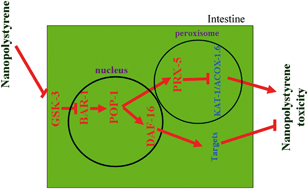Response of intestinal signaling communication between the nucleus and peroxisome to nanopolystyrene at a predicted environmental concentration†
Abstract
The molecular responses of organisms to environmental toxicants at environmentally relevant concentrations are still largely unknown. Nematode Caenorhabditis elegans is a sensitive animal model used for environmental exposure assessment. We here determined the role of canonical Wnt/β-catenin signaling, a conserved molecular signaling among different organisms, in regulating the response of nematodes to nanopolystyrene (100 nm) at a predicted environmental concentration (1 μg L−1) and the underlying mechanism. Among the components of the canonical Wnt/β-catenin signaling pathway, nanopolystyrene (1 μg L−1) only decreased GSK-3 expression and increased β-catenin BAR-1 expression. GSK-3 acted upstream of BAR-1 to regulate the response to nanopolystyrene, and the intestine-specific activity of the GSK-3-BAR-1 signaling cascade in regulating the response to nanopolystyrene was observed. Transcriptional factor DAF-16 and peroxisomal protein PRX-5 were identified as downstream targets of both BAR-1 and Wnt effector POP-1 in regulating the response to nanopolystyrene. During the control of the response to nanopolystyrene, DAF-16 and PRX-5 functioned synergistically, suggesting that the intestinal canonical Wnt/β-catenin signaling mediates two different molecular signals to regulate the response to nanopolystyrene. In the peroxisome, KAT-1 and ACOX-1.6 were further identified as downstream targets of PRX-5 to regulate the response to nanopolystyrene. Therefore, exposure to nanopolystyrene could activate the canonical Wnt/β-catenin-mediated signaling communication between the nucleus and peroxisome. Our results suggest the crucial function of intestinal canonical Wnt/β-catenin-mediated nucleus–peroxisome signaling communication in response to nanopolystyrene exposure at a predicted environmental concentration.



 Please wait while we load your content...
Please wait while we load your content...